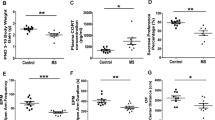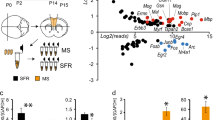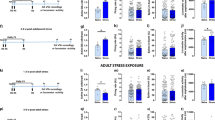Abstract
Maternal separation (MS) is an early life stress model that induces permanent changes in the central nervous system, impairing hippocampal long-term potentiation (LTP) and spatial working memory. There are compelling evidences for a role of hippocampal adenosine A2A receptors in stress-induced modifications related to cognition, thus opening a potential window for therapeutic intervention. Here, we submitted rats to MS and evaluated the long-lasting molecular, electrophysiological and behavioral impairments in adulthood. We then assessed the therapeutic potential of KW6002, a blocker of A2A receptors, in stress-impaired animals. We report that the blockade of A2A receptors was efficient in reverting the behavior, electrophysiological and morphological impairments induced by MS. In addition, this effect is associated with restoration of the hypothalamic-pituitary-adrenal axis (HPA-axis) activity, as both the plasma corticosterone levels and hippocampal glucocorticoid receptor expression pattern returned to physiological-like status after the treatment. These results reveal the involvement of A2A receptors in the stress-associated impairments and directly in the stress response system by showing that the dysfunction of the HPA-axis as well as the long-lasting synaptic and behavioral effects of MS can be reverted by targeting adenosine A2A receptors. These findings provide a novel evidence for the use of adenosine A2A receptor antagonists as potential therapy against psychopathologies.
This is a preview of subscription content, access via your institution
Access options
Subscribe to this journal
Receive 12 print issues and online access
$259.00 per year
only $21.58 per issue
Buy this article
- Purchase on Springer Link
- Instant access to full article PDF
Prices may be subject to local taxes which are calculated during checkout





Similar content being viewed by others
References
McEwen BS . Stress and hippocampal plasticity. Annu Rev Neurosci 1999; 22: 105–122.
McEwen BS . Stress and the aging hippocampus. Front Neuroendocrinol 1999; 20: 49–70.
McKinney WT . Animal models of depression: an overview. Psychiatr Dev 1984; 2: 77–96.
Willner P . Validity, reliability and utility of the chronic mild stress model of depression: a 10-year review and evaluation. Psychopharmacology (Berl) 1997; 134: 319–329.
Sullivan R, Wilson DA, Feldon J, Yee BK, Meyer U, Richter-Levin G et al. The International Society for Developmental Psychobiology annual meeting symposium: impact of early life experiences on brain and behavioral development. Dev Psychobiol 2006; 48: 583–602.
Heim C, Nemeroff CB . The role of childhood trauma in the neurobiology of mood and anxiety disorders: preclinical and clinical studies. Biol Psychiatry 2001; 49: 1023–1039.
Ladd CO, Huot RL, Thrivikraman KV, Nemeroff CB, Meaney MJ, Plotsky PM . Long-term behavioral and neuroendocrine adaptations to adverse early experience. Prog Brain Res 2000; 122: 81–103.
Morris RG . Long-term potentiation and memory. Philos Trans R Soc Lond B Biol Sci 2003; 358: 643–647.
de Kloet ER, Oitzl MS, Joels M . Stress and cognition: are corticosteroids good or bad guys? Trends Neurosci 1999; 22: 422–426.
Amaral DG, Dent JA . Development of the mossy fibers of the dentate gyrus: I. A light and electron microscopic study of the mossy fibers and their expansions. J Comp Neurol 1981; 195: 51–86.
Sapolsky RM, Meaney MJ . Maturation of the adrenocortical stress response: neuroendocrine control mechanisms and the stress hyporesponsive period. Brain Res 1986; 396: 64–76.
Kaufman J, Plotsky PM, Nemeroff CB, Charney DS . Effects of early adverse experiences on brain structure and function: clinical implications. Biol Psychiatry 2000; 48: 778–790.
Bakshi VP, Kalin NH . Corticotropin-releasing hormone and animal models of anxiety: gene-environment interactions. Biol Psychiatry 2000; 48: 1175–1198.
Aisa B, Tordera R, Lasheras B, Del Rio J, Ramirez MJ . Cognitive impairment associated to HPA axis hyperactivity after maternal separation in rats. Psychoneuroendocrinology 2007; 32: 256–266.
Anisman H, Zaharia MD, Meaney MJ, Merali Z . Do early-life events permanently alter behavioral and hormonal responses to stressors? Int J Dev Neurosci 1998; 16: 149–164.
Lehmann J, Stohr T, Feldon J . Long-term effects of prenatal stress experiences and postnatal maternal separation on emotionality and attentional processes. Behav Brain Res 2000; 107: 133–144.
Cunha RA, Johansson B, van der Ploeg I, Sebastiao AM, Ribeiro JA, Fredholm BB . Evidence for functionally important adenosine A2a receptors in the rat hippocampus. Brain Res 1994; 649: 208–216.
Cunha RA, Constantino MC, Sebastiao AM, Ribeiro JA . Modification of A1 and A2a adenosine receptor binding in aged striatum, hippocampus and cortex of the rat. Neuroreport 1995; 6: 1583–1588.
Lopes LV, Cunha RA, Ribeiro JA . Increase in the number, G protein coupling, and efficiency of facilitatory adenosine A2A receptors in the limbic cortex, but not striatum, of aged rats. J Neurochem 1999; 73: 1733–1738.
Rebola N, Sebastiao AM, de Mendonca A, Oliveira CR, Ribeiro JA, Cunha RA . Enhanced adenosine A2A receptor facilitation of synaptic transmission in the hippocampus of aged rats. J Neurophysiol 2003; 90: 1295–1303.
Cunha RA . Neuroprotection by adenosine in the brain: from A(1) receptor activation to A (2A) receptor blockade. Purinergic Signal 2005; 1: 111–134.
Cunha GM, Canas PM, Oliveira CR, Cunha RA . Increased density and synapto-protective effect of adenosine A2A receptors upon sub-chronic restraint stress. Neuroscience 2006; 141: 1775–1781.
Belanoff JK, Gross K, Yager A, Schatzberg AF . Corticosteroids and cognition. J Psychiatr Res 2001; 35: 127–145.
Belanoff JK, Kalehzan M, Sund B, Fleming Ficek SK, Schatzberg AF . Cortisol activity and cognitive changes in psychotic major depression. Am J Psychiatry 2001; 158: 1612–1616.
Daniels WM, Pietersen CY, Carstens ME, Stein DJ . Maternal separation in rats leads to anxiety-like behavior and a blunted ACTH response and altered neurotransmitter levels in response to a subsequent stressor. Metab Brain Dis 2004; 19: 3–14.
Lopes LV, Marvin-Guy LF, Fuerholz A, Affolter M, Ramadan Z, Kussmann M et al. Maternal deprivation affects the neuromuscular protein profile of the rat colon in response to an acute stressor later in life. J Proteomics 2008; 71: 80–88.
Yang M, Soohoo D, Soelaiman S, Kalla R, Zablocki J, Chu N et al. Characterization of the potency, selectivity, and pharmacokinetic profile for six adenosine A2A receptor antagonists. Naunyn Schmiedebergs Arch Pharmacol 2007; 375: 133–144.
Morris RG, Garrud P, Rawlins JN, O'Keefe J . Place navigation impaired in rats with hippocampal lesions. Nature 1982; 297: 681–683.
Diogenes MJ, Costenla AR, Lopes LV, Jeronimo-Santos A, Sousa VC, Fontinha BM et al. Enhancement of LTP in aged rats is dependent on endogenous BDNF. Neuropsychopharmacology 2011; 36: 1823–1836.
Pellow S, Chopin P, File SE, Briley M . Validation of open:closed arm entries in an elevated plus-maze as a measure of anxiety in the rat. J Neurosci Methods 1985; 14: 149–167.
Gibb R, Kolb B . A method for vibratome sectioning of Golgi-Cox stained whole rat brain. J Neurosci Methods 1998; 79: 1–4.
Keuker JI, Vollmann-Honsdorf GK, Fuchs E . How to use the optical fractionator: an example based on the estimation of neurons in the hippocampal CA1 and CA3 regions of tree shrews. Brain Res Brain Res Protoc 2001; 7: 211–221.
Madeira MD, Pereira A, Cadete-Leite A, Paula-Barbosa MM . Estimates of volumes and pyramidal cell numbers in the prelimbic subarea of the prefrontal cortex in experimental hypothyroid rats. J Anat 1990; 171: 41–56.
Glaser EM, Van der Loos H . Analysis of thick brain sections by obverse-reverse computer microscopy: application of a new, high clarity Golgi-Nissl stain. J Neurosci Methods 1981; 4: 117–125.
Paxinos G, Watson C . The Rat Brain in Stereotaxic Coordinates. 3rd edn. Academic Press: Waltham, MA, USA, 1998.
Palomero-Gallagher N, Zilles K . The rat isocortex. In: Paxinos G (ed). The Rat Nervous System. Academic Press: San Diego, CA, USA, 2004; 728–760.
Gundersen HJ, Bagger P, Bendtsen TF, Evans SM, Korbo L, Marcussen N et al. The new stereological tools: disector, fractionator, nucleator and point sampled intercepts and their use in pathological research and diagnosis. APMIS 1988; 96: 857–881.
Palacios SD, Pak K, Rivkin AZ, Kayali AG, Austen D, Aletsee C et al. Role of p38 mitogen-activated protein kinase in middle ear mucosa hyperplasia during bacterial otitis media. Infect Immun 2004; 72: 4662–4667.
Lowry OH, Rosebrough NJ, Farr AL, Randall RJ . Protein measurement with the Folin phenol reagent. J Biol Chem 1951; 193: 265–275.
Bradford MM . A rapid and sensitive method for the quantitation of microgram quantities of protein utilizing the principle of protein-dye binding. Anal Biochem 1976; 72: 248–254.
Lopes LV, Cunha RA, Ribeiro JA . Cross talk between A(1) and A(2A) adenosine receptors in the hippocampus and cortex of young adult and old rats. J Neurophysiol 1999; 82: 3196–3203.
Hockemeyer J, Burbiel JC, Muller CE . Multigram-scale syntheses, stability, and photoreactions of A2A adenosine receptor antagonists with 8-styrylxanthine structure: potential drugs for Parkinson's disease. J Org Chem 2004; 69: 3308–3318.
Aisa B, Elizalde N, Tordera R, Lasheras B, Del Rio J, Ramirez MJ . Effects of neonatal stress on markers of synaptic plasticity in the hippocampus: implications for spatial memory. Hippocampus 2009; 19: 1222–1231.
Pickering C, Gustafsson L, Cebere A, Nylander I, Liljequist S . Repeated maternal separation of male Wistar rats alters glutamate receptor expression in the hippocampus but not the prefrontal cortex. Brain Res 2006; 1099: 101–108.
Joels M . Corticosteroid effects in the brain: U-shape it. Trends Pharmacol Sci 2006; 27: 244–250.
Janusz CA, Berman RF . The A2-selective adenosine analog, CGS 21680, depresses locomotor activity but does not block amygdala kindled seizures in rats. Neurosci Lett 1992; 141: 247–250.
Meerlo P, Roman V, Farkas E, Keijser JN, Nyakas C, Luiten PG . Ageing-related decline in adenosine A1 receptor binding in the rat brain: an autoradiographic study. J Neurosci Res 2004; 78: 742–748.
Pardon MC, Rattray I . What do we know about the long-term consequences of stress on ageing and the progression of age-related neurodegenerative disorders? Neurosci Biobehav Rev 2008; 32: 1103–1120.
Miller DB, O'Callaghan JP . Aging, stress and the hippocampus. Ageing Res Rev 2005; 4: 123–140.
Reul JM, de Kloet ER . Two receptor systems for corticosterone in rat brain: microdistribution and differential occupation. Endocrinology 1985; 117: 2505–2511.
Gruen RJ, Wenberg K, Elahi R, Friedhoff AJ . Alterations in GABAA receptor binding in the prefrontal cortex following exposure to chronic stress. Brain Res 1995; 684: 112–114.
Meller E, Shen C, Nikolao TA, Jensen C, Tsimberg Y, Chen J et al. Region-specific effects of acute and repeated restraint stress on the phosphorylation of mitogen-activated protein kinases. Brain Res 2003; 979: 57–64.
Mizoguchi K, Ikeda R, Shoji H, Tanaka Y, Maruyama W, Tabira T . Aging attenuates glucocorticoid negative feedback in rat brain. Neuroscience 2009; 159: 259–270.
Sapolsky RM, Meaney MJ, McEwen BS . The development of the glucocorticoid receptor system in the rat limbic brain. III. Negative-feedback regulation. Brain Res 1985; 350: 169–173.
Sapolsky RM, Krey LC, McEwen BS . Stress down-regulates corticosterone receptors in a site-specific manner in the brain. Endocrinology 1984; 114: 287–292.
Sousa N, Cerqueira JJ, Almeida OF . Corticosteroid receptors and neuroplasticity. Brain Res Rev 2008; 57: 561–570.
Lopes LV, Cunha RA, Kull B, Fredholm BB, Ribeiro JA . Adenosine A(2A) receptor facilitation of hippocampal synaptic transmission is dependent on tonic A(1) receptor inhibition. Neuroscience 2002; 112: 319–329.
Dias RB, Ribeiro JA, Sebastiao AM . Enhancement of AMPA currents and GluR1 membrane expression through PKA-coupled adenosine A(2A) receptors. Hippocampus 2012; 22: 276–291.
Costenla AR, Diogenes MJ, Canas PM, Rodrigues RJ, Nogueira C, Maroco J et al. Enhanced role of adenosine A(2A) receptors in the modulation of LTP in the rat hippocampus upon ageing. Eur J Neurosci 2011; 34: 12–21.
Rebola N, Carta M, Lanore F, Blanchet C, Mulle C . NMDA receptor-dependent metaplasticity at hippocampal mossy fiber synapses. Nat Neurosci 2011; 14: 691–693.
Batalha VL, Hamdane M, Sebastião AM, Buée L, Blum D, Lopes LV . Modulation of glucocorticoid receptor (GR) transcriptional activity by adenosine A2A receptors: consequences for stress response. Champalimaud Neurosci Symp 2011; http://symposium.neuro.fchampalimaud.org/files/CNP_symp_Abstracts_2.pdf.
Ledent C, Vaugeois JM, Schiffmann SN, Pedrazzini T, El Yacoubi M, Vanderhaeghen JJ et al. Aggressiveness, hypoalgesia and high blood pressure in mice lacking the adenosine A2a receptor. Nature 1997; 388: 674–678.
Hauser RA, Hubble JP, Truong DD . Randomized trial of the adenosine A(2A) receptor antagonist istradefylline in advanced PD. Neurology 2003; 61: 297–303.
Andrasfalvy BK, Smith MA, Borchardt T, Sprengel R, Magee JC . Impaired regulation of synaptic strength in hippocampal neurons from GluR1-deficient mice. J Physiol 2003; 552 (Part 1): 35–45.
Martin S, Henley JM, Holman D, Zhou M, Wiegert O, van Spronsen M et al. Corticosterone alters AMPAR mobility and facilitates bidirectional synaptic plasticity. PLoS One 2009; 4: e4714.
Bessa JM, Ferreira D, Melo I, Marques F, Cerqueira JJ, Palha JA et al. The mood-improving actions of antidepressants do not depend on neurogenesis but are associated with neuronal remodeling. Mol Psychiatry 2009; 14: 764–773, 739.
Allen C, Kendall JW . Maturation of the circadian rhythm of plasma corticosterone in the rat. Endocrinology 1967; 80: 926–930.
Anand-Srivastava MB, Cantin M, Gutkowska J . Adenosine regulates the release of adrenocorticotropic hormone (ACTH) from cultured anterior pituitary cells. Mol Cell Biochem 1989; 89: 21–28.
Acknowledgements
We acknowledge Alexandre de Mendonça, David Blum and Rodrigo Cunha for helpful discussions. VLB is thankful to João Baião and Carla Batalha for technical assistance. VLB has been awarded a PhD fellowship from Fundação para a Ciência e Tecnologia (BD/63041/2009). LVL is funded by Fundação para a Ciência e Tecnologia (PTDC/SAU-NEU/099853/2008) and by EU programme Égide-Pessoa. YB and CEM were funded by the Ministry for Education and Research (BMBF, Grant number 01EW0911) in the frame of ERA-NET NEURON.
Author information
Authors and Affiliations
Corresponding author
Ethics declarations
Competing interests
The authors declare no conflict of interest.
Additional information
Supplementary Information accompanies the paper on the Molecular Psychiatry website
Rights and permissions
About this article
Cite this article
Batalha, V., Pego, J., Fontinha, B. et al. Adenosine A2A receptor blockade reverts hippocampal stress-induced deficits and restores corticosterone circadian oscillation. Mol Psychiatry 18, 320–331 (2013). https://doi.org/10.1038/mp.2012.8
Received:
Revised:
Accepted:
Published:
Issue Date:
DOI: https://doi.org/10.1038/mp.2012.8
Keywords
This article is cited by
-
Lateral septum adenosine A2A receptors control stress-induced depressive-like behaviors via signaling to the hypothalamus and habenula
Nature Communications (2023)
-
Adenosine A2A receptors control generalization of contextual fear in rats
Translational Psychiatry (2023)
-
Adenosine A2A receptors blockade attenuates dexamethasone-induced alterations in cultured astrocytes
Purinergic Signalling (2022)
-
Caffeine protects against stress-induced murine depression through activation of PPARγC1α-mediated restoration of the kynurenine pathway in the skeletal muscle
Scientific Reports (2021)
-
Adenosine Signaling and Clathrin-Mediated Endocytosis of Glutamate AMPA Receptors in Delayed Hypoxic Injury in Rat Hippocampus: Role of Casein Kinase 2
Molecular Neurobiology (2021)



